Quiver
1 Overview
The unique characteristic of graph learning systems is that the preprocessing with graph structures and the collection of features are usually the bottlenecks. How to resolve those two bottlenecks? Quiver's core ideas are: - Graph sampling is a latency critical problem, so massive parallelism could hide the latency. - Feature collection is a bandwidth critical problem, so bandwidth should be optimized to achieve high performance.

Normally, we choose to use CPU to sample the graph and collect features. This strategy will not only cause performance issues when we use single-GPU training but also cause poor scalability because of CPU resource sharing. Below is the benchmark of training ogbn-product with PYG and DGL, on the scalability of multi-GPU training with CPU sampling and feature collection:
Note: Benchmark code here
| Framework | Device Num | Epoch Time(s) | Scalability |
|---|---|---|---|
| Pyg | 1 | 36.5 | 1.0 |
| Pyg | 2 | 31.3 | 1.16 |
| Pyg | 3 | 28.1 | 1.30 |
| Pyg | 4 | 29.1 | 1.25 |
| DGL | 1 | ||
| DGL | 2 | ||
| DGL | 3 | ||
| DGL | 4 |
Our Quiver is a high-performance GNN training add-on which can fully utilize the hardware. Users will have better end-to-end performance and better scalability of multi-GPU GNN training. We even achieve super linear scalability with the help of NVLink. Next we will introduce our contributions on the optimizations of graph sampling and feature collection.
2 Graph Sampling
2.1 Existing Approaches
Existing graph learning frameworks support both CPU and GPU sampling. GPU sampling needs to store the entire graph structure on GPU memory, which is a limit when the graph is large. CPU sampling has poor performance and bad scalability.
2.2 Quiver's Approach
Note: Benchmark codehere
Quiver provide users with UVA-Based(Unified Virtual Addressing Based)graph sampling operator, supporting storing graph structure in CPU memory and sampling the graph with GPU when the graph is large. In this way, we not only get performance benefits beyond CPU sampling, but also sample the graph whose size is beyond GPU memory. We evaluate our sampling performance on ogbn-productsandreddit datasets, and we find that the performance of UVA-based sampling is much higher than CPU sampling. Our sampling metrics are the sampling throughput (Sampled Edges Per Second, SEPS). We can observe that without storing the graph on GPU, Quiver get 20x speedup on real datasets.
| Dataset | Parameter | Sampler | SEPS | Speedup Over CPU |
|---|---|---|---|---|
| ogbn-product | [15, 10, 5] | CPU | 1.84 M | 1.0 |
| ogbn-product | [15, 10, 5] | UVA(on host memory) |
34.29 M | 18.63 |
| [25, 10] | CPU | 2 M | 1.0 | |
| [25, 10] | UVA(on host memory) |
33.15 M | 16.575 |
Meanwhile, Quiver's sampling can be configured to enable GPU-only sampling (mode='GPU'), which put the whole graph structure to GPU memory to achieve higher performance. Compared to UVA mode, this sampling strategy will 30-40% speedup with extra GPU memory cost.
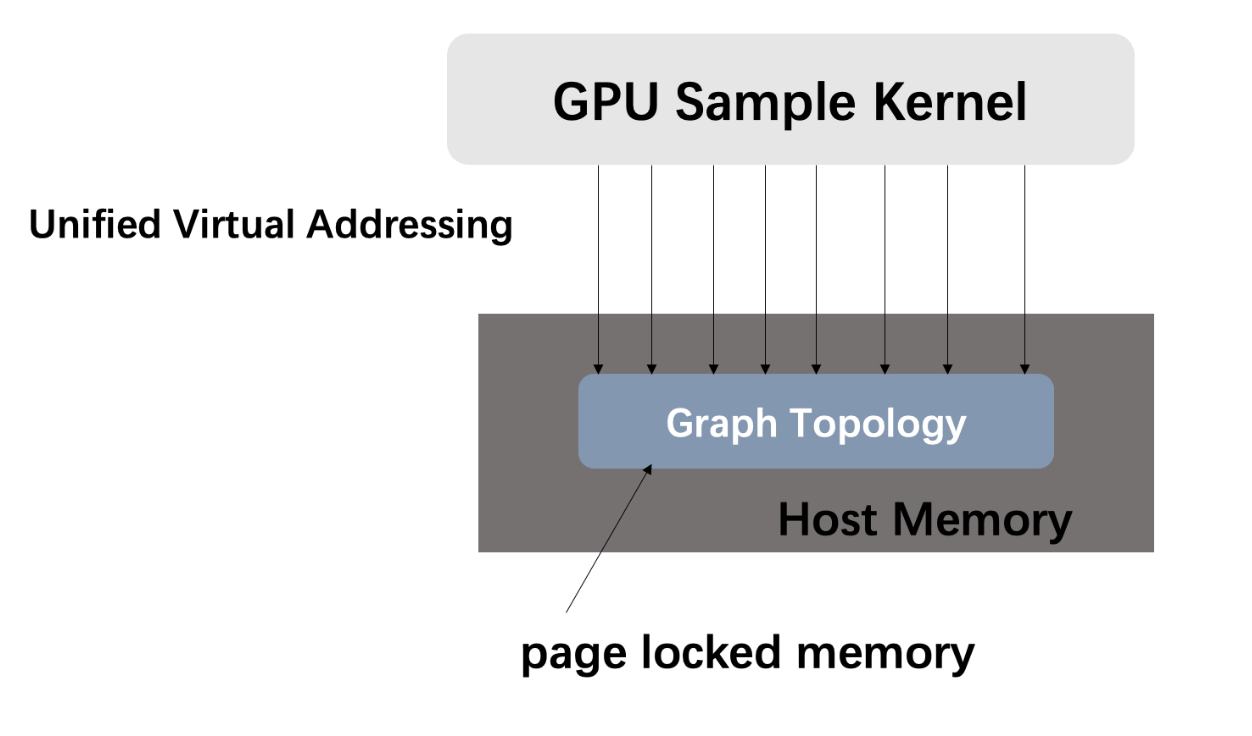
dataset = PygNodePropPredDataset('ogbn-products', root)
csr_topo = quiver.CSRTopo(dataset[0].edge_index)
# You can set mode='GPU' to choose place graph data in GPU memory
quiver_sampler = quiver.pyg.GraphSageSampler(csr_topo, [15, 10, 5], device=0, mode="UVA")
Furthermore, UVA sampling will not cost CPU computation resources, which avoid contention when we train with multiple GPUs and have a better scalability. This part will be further explained in our end-to-end performance benchmark.
3 Feature Collection
Note: Benchmark codehere
3.1 Existing Approaches
The feature size of one batch in GNN training is usually hundreds of MB or even several GB. The feature collection time, especially the CPU-to-GPU case, have significant cost. The core idea of optimizing feature collection is to optimise the throughput of feature transfer. Existing approaches are:
- Collect feature on CPU, and transfer the result to GPU for training
- When feature size is small, put all feature data on GPU and collect the batch
Approach 1 has a much lower throughput, and it has a poor scalability because multiple workers will share CPU memory bandwidth.
3.2 Quiver's Approach
Quiver provides feature collection quiver.Feature with high throughput. The implementation of quiver.Feature is based on two observations below:
- Real graph datasets usually follow the power low, which means most of the edges in the graph are associated with a small portion of nodes. Most sampling algorithms based on graph structure will sample more nodes whose degree are higher. We show in the table below that two datasets follow our observations.
| Dataset | #(degree > average_degree)/total_nodes_count | #edges(with node degree > average)/total_edges_count |
|---|---|---|
| ogbn-product | 31.3% | 76.8% |
| 29.8% | 77.1% |
- Memory bandwidth relationship of a GPU server is: GPU Global Memory > GPU P2P With NVLink > Pinned Memory > Pageble Memory.
Considering the bandwidth and the power law, Quiver's quiver.Feature can allocate features automatically to GPU memory and CPU Pinned Memory. It can also host hot data on GPU and cold data on CPU (if csr_topo is provided). We collect features with GPU.
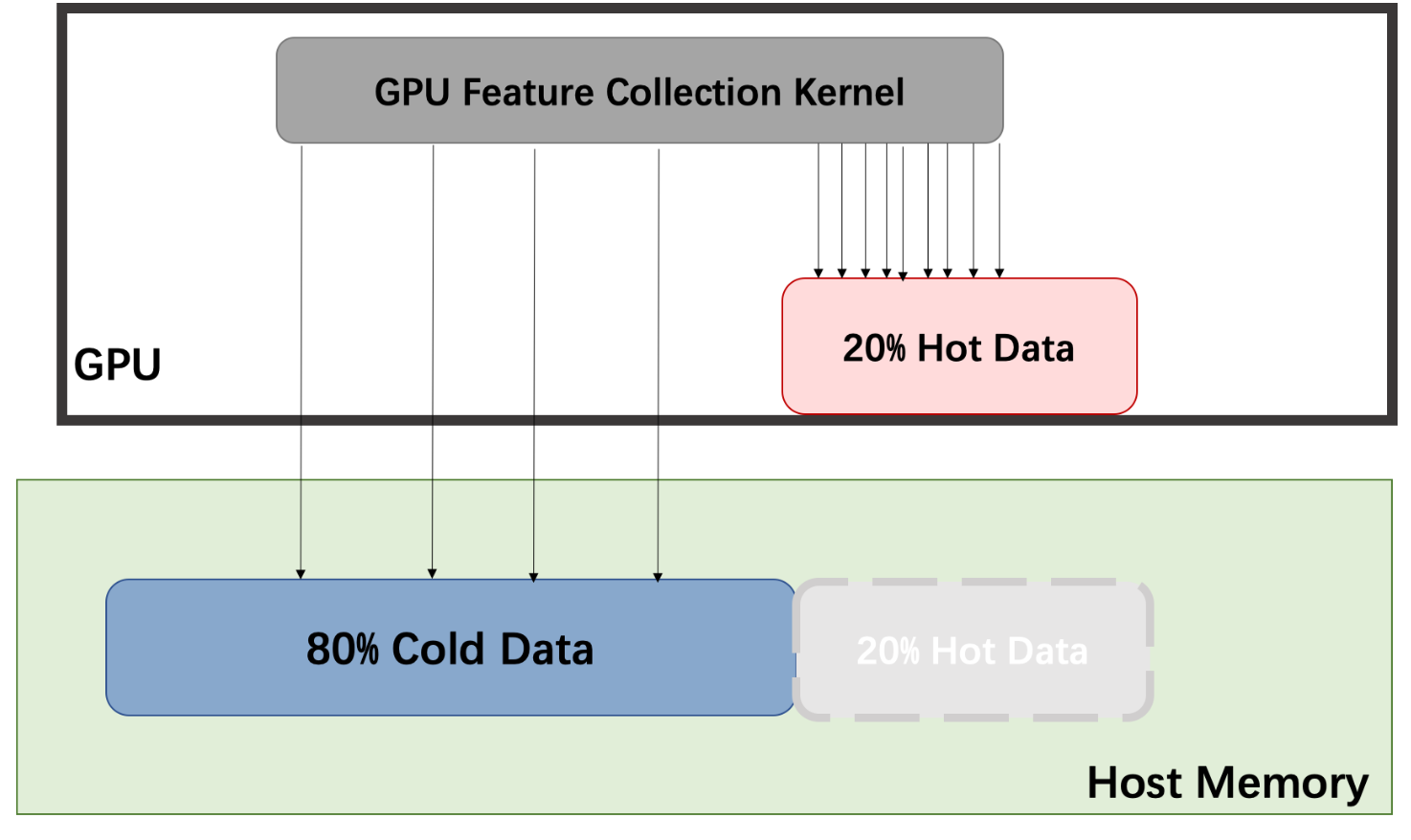
3.2.1 Single-GPU
First we show our performance of feature collection using one GPU. The table below shows the performance of quiver.Feature when we cache 20% hot data on GPU cpmpare with normal CPU feature collection.
| Dataset | Feature | Throughput(GB/s) | Speedup Over CPU |
|---|---|---|---|
| ogbn-product | CPU | 1.27 | 1.0 |
| ogbn-product | Quiver | 14.82 | 10 |
| CPU | 2.98 | 1.0 | |
| Quiver | 11.66 | 3.91 |
3.2.2 Multi-GPU
Multi-GPU caching strategy can be classified as device_replicate and p2p_clique_replicate, depending on whether NVLink is supported between GPUs. First, we take a look at device_replicate.
device replicate
device_replicate strategy is to replicate hot data across GPUs, and they will share the cold data on CPU memory.
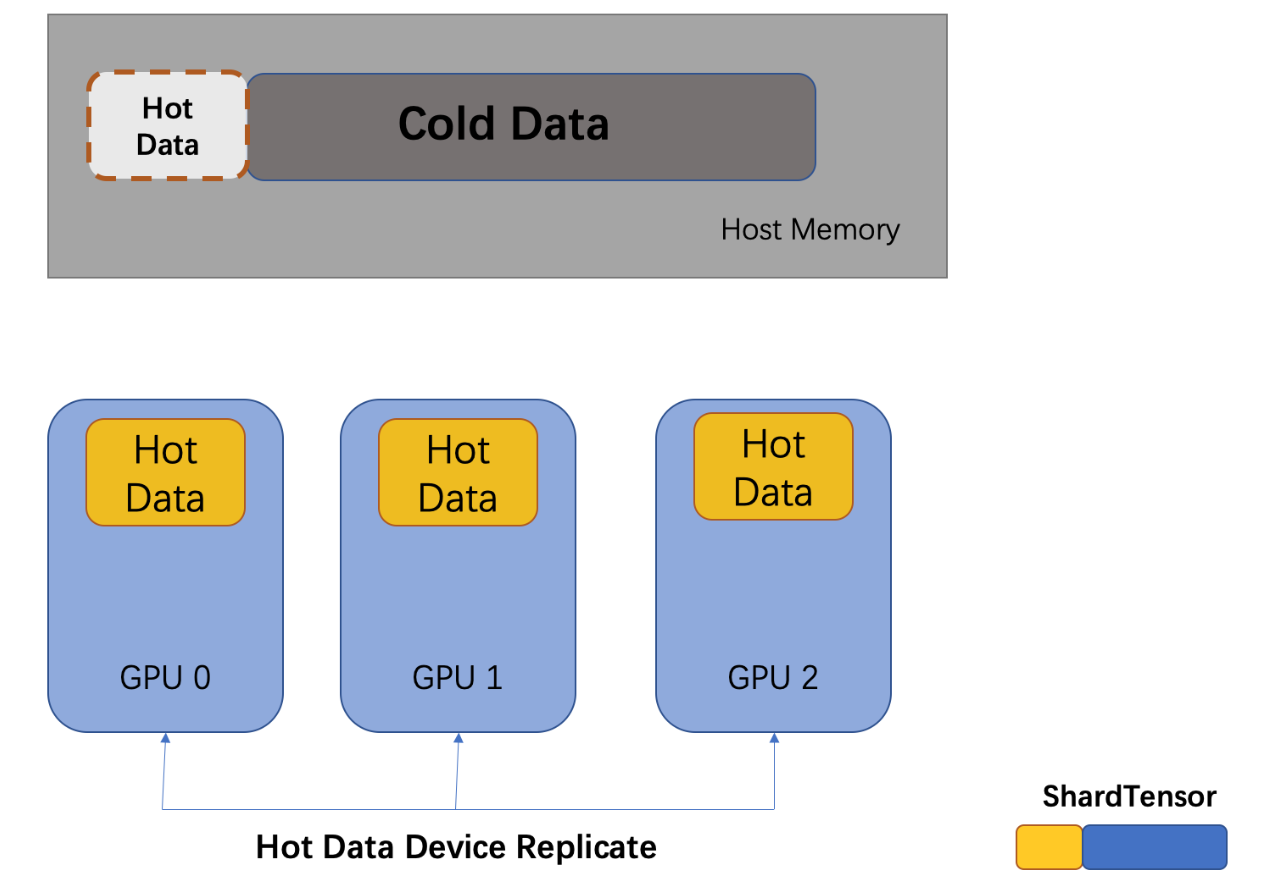
p2p_clique_replicate
When NVLink is supported, feature collection with P2P between GPUs has a higher bandwidth than collecting features from CPU, so GPUs inside a p2p_clique will share a hot feature cache. The hot data cache will be larger when each GPU hold a partition of it.
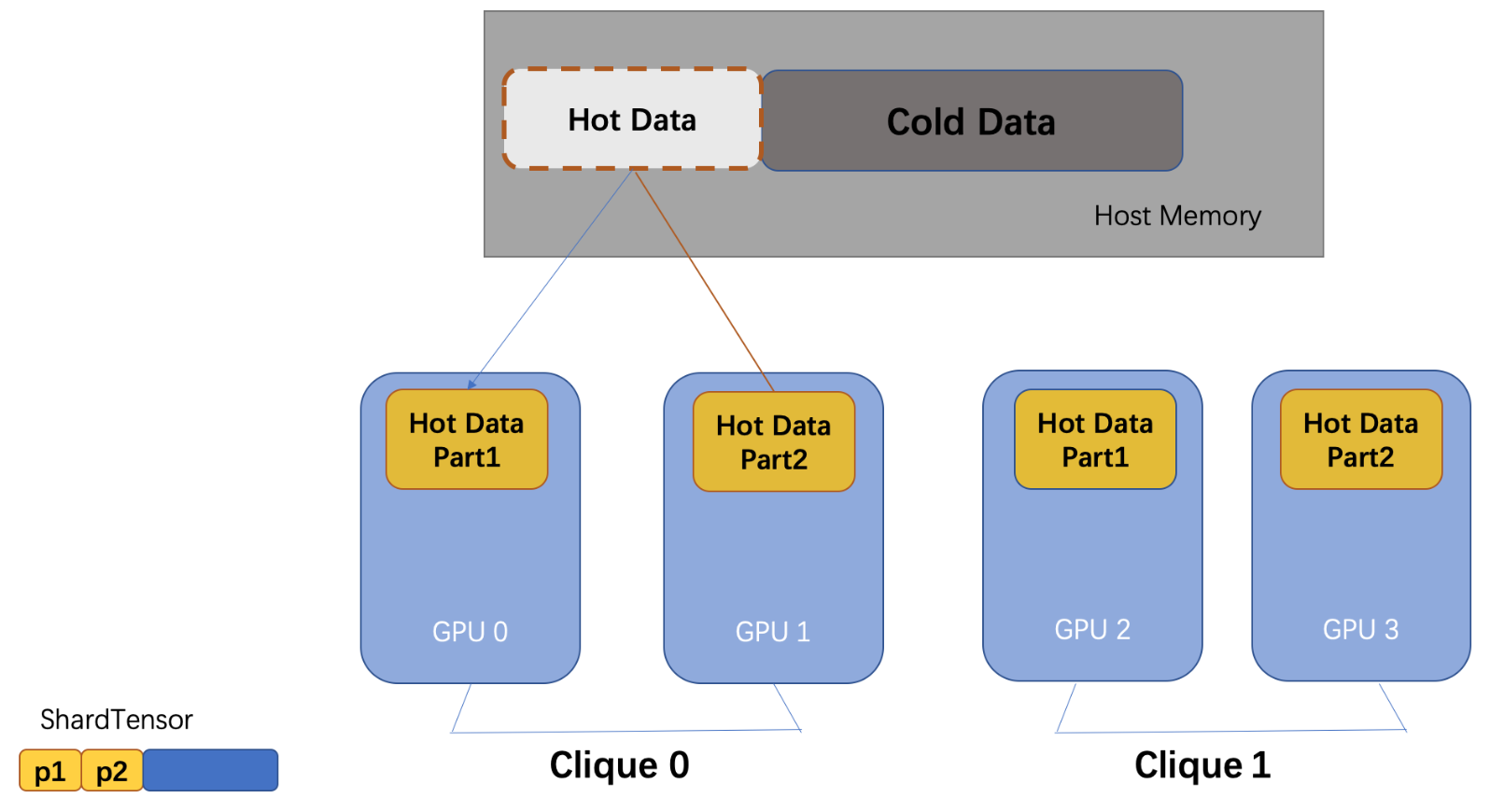
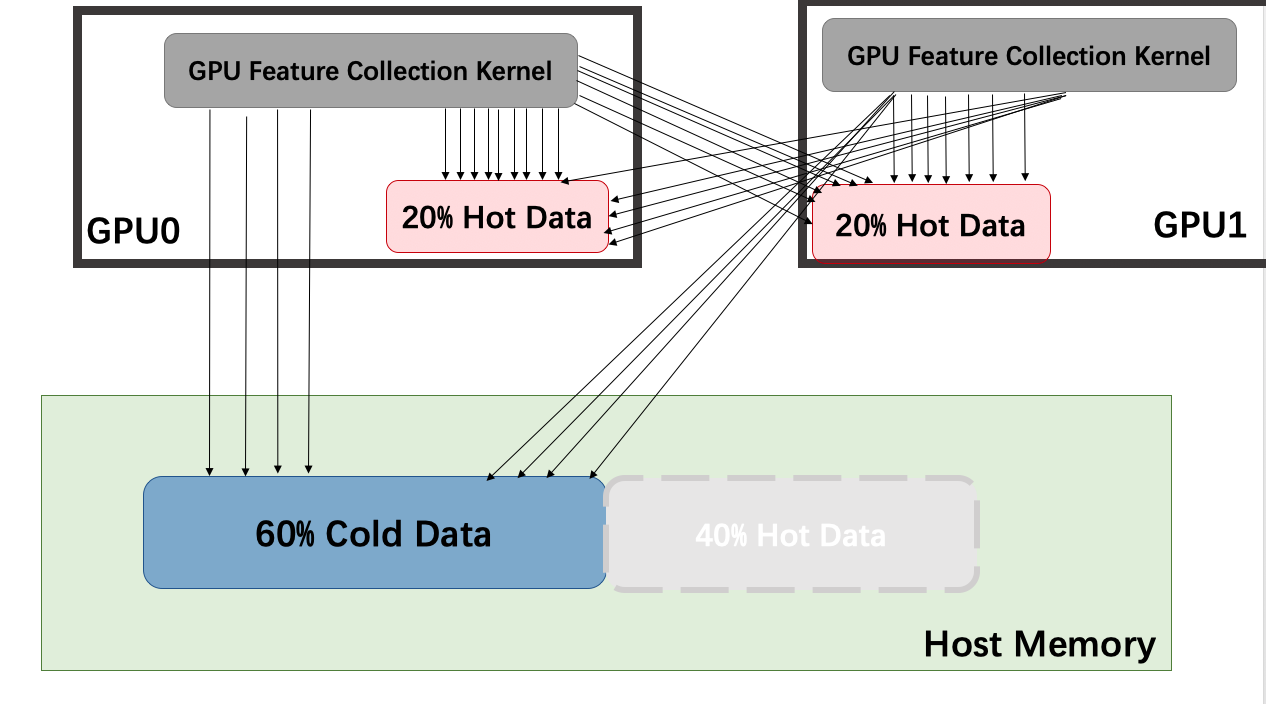
In this way we provide larger cache size, and we achieve super-linear scalability because the interconnects between hot cache partitions are much higher.
| Dataset | Device Num | Total Throughput(GB/s) | Speedup Over Single Device |
|---|---|---|---|
| ogbn-product | 1 | 20.29 | 1.0 |
| ogbn-product | 2 | 108.6 | 5.35 |
| 1 | 1.0 | ||
| 2 | 3.91 |
The super-linear scalability of feature collection will make the super-linear speedup of the whole training pipeline.
# set cache_policy="device_replicate" if you dont have NVLink
quiver_feature = quiver.Feature(rank=0, device_list=[0, 1], device_cache_size="110M", cache_policy="p2p_clique_replicate", csr_topo=csr_topo)
quiver_feature.from_cpu_tensor(dataset[0].x)
4 End-to-end Performance
Quiver provides high-performance components for GNN training. Users will have the freedom to make choices of sampling and feature collection combined strategy.
4.1 cache_policy = device_replicate
We evaluate on the ogbn-product dataset, and we compare Quiver with CPU feature collection and sampling from Pyg. The parallelism of each sampling process is 5.
| Device Num | Pyg's Epoch Time | Pyg's Scalability | Quiver's Epoch Time | Quiver's Scalability | Quiver Over Pyg |
|---|---|---|---|---|---|
| 1 | 36.5 | 1.0 | 11.1 | 1.0 | 3.23 |
| 2 | 30 | 1.22 | 5.8 | 1.91 | 5.17 |
| 3 | 27.7 | 1.32 | 4.7 | 2.71 | 6.75 |
| 4 | 28.2 | 1.28 | 3.25 | 3.42 | 8.68 |
Even when we put all feature on GPU and use GPU to collect feature, Quiver still have 3x speedup over Pyg.
| Device Num | Pyg's Epoch Time | Pyg's Scalability | Quiver Over Pyg |
|---|---|---|---|
| 1 | 23.3 | 1.0 | 2.1 |
| 2 | 14.7 | 1.59 | 2.53 |
| 3 | 11.4 | 2.04 | 2.78 |
| 4 | 9.5 | 2.45 | 2.92 |
We show that Quiver has a better performance and a better scalability.
4.2 cache_policy = p2p_clique_replicate
When we train ogb-product and reddit datasets on the machine with NVLink, the speedup with 2 GPUs are 2.25 and 2.75(batch_size=2048), which shows the super-linear scalability of our feature collection strategy.
4 Future Works
This time we open-source the single-machine version of Quiver. Next we will work on new features below:
- Adaptive allocation: Now the strategy choice of feature collection and sampling is manually configured. This could be improved by providing the mechanism of making such decisions automatically according to the characteristics of the workload and hardware.
- Distributed Quiver:Next we will support multi-machine distributed version of Quiver to train larger datasets.
5 End
The quiver-team community will work on adaptive and scalable AI systems. Quiver will fully utilize hardware to help users train GNN efficiently. Quiver is being developed actively, and we hope people who are interested can build Quiver and make it a better GNN system.
